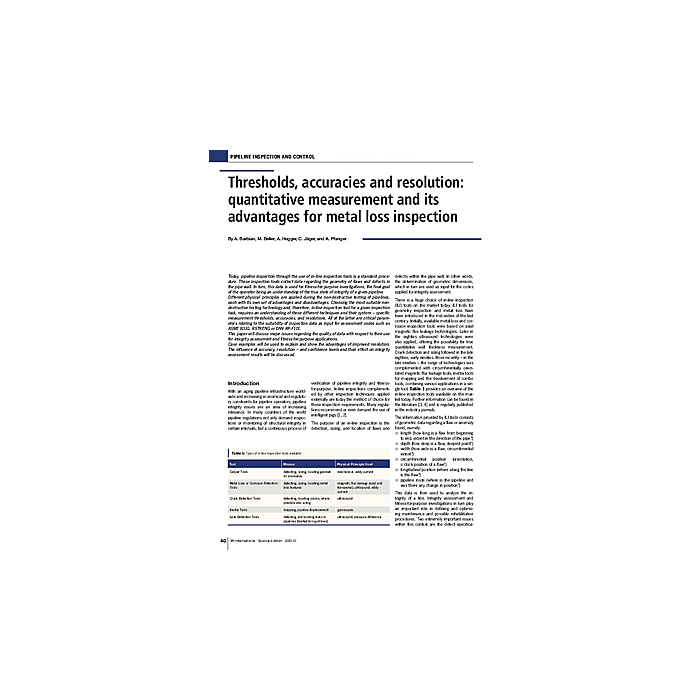Thresholds, accuracies and resolution: quantitative measurement and its advantages for metal loss inspection
€4.90
In stock
article number
01252_2010_SP2_07
Today, pipeline inspection through the use of in-line inspection tools is a standard procedure. These inspection tools collect data regarding the geometry of flaws and defects in the pipe wall. In turn, this data is used for fitness-for-purpose investigations, the final goal of the operator being an understanding of the true state of integrity of a given pipeline. Different physical principles are applied during the non-destructive testing of pipelines, each with its own set of advantages and disadvantages. Choosing the most suitable non-destructive testing technology and, therefore, in-line inspection tool for a given inspection task, requires an understanding of these different techniques and their system - specific measurement thresholds, accuracies, and resolutions. All of the latter are critical parameters relating to the suitability of inspection data as input for assessment codes such as ASME B31G, RSTRENG or DNV RP-F101. This paper will discuss major issues regarding the quality of data with respect to their use for integrity assessment and fitness-for-purpose applications. Case examples will be used to explain and show the advantages of improved resolution. The influence of accuracy, resolution - and confidence levels and their effect on integrity assessment results will be discussed.
| Authors | A. Barbian/M. Beller, A. Hugger, C. Jäger, A. Pfanger |
|---|---|
| Publishing Date | 30 Sept 2010 |
| Format | |
| Zeitschrift | 3R - Special 2 2010 |
| Publisher | Vulkan-Verlag GmbH |
| Language | German |
| Title | Thresholds, accuracies and resolution: quantitative measurement and its advantages for metal loss inspection |
| Description | Today, pipeline inspection through the use of in-line inspection tools is a standard procedure. These inspection tools collect data regarding the geometry of flaws and defects in the pipe wall. In turn, this data is used for fitness-for-purpose investigations, the final goal of the operator being an understanding of the true state of integrity of a given pipeline. Different physical principles are applied during the non-destructive testing of pipelines, each with its own set of advantages and disadvantages. Choosing the most suitable non-destructive testing technology and, therefore, in-line inspection tool for a given inspection task, requires an understanding of these different techniques and their system - specific measurement thresholds, accuracies, and resolutions. All of the latter are critical parameters relating to the suitability of inspection data as input for assessment codes such as ASME B31G, RSTRENG or DNV RP-F101. This paper will discuss major issues regarding the quality of data with respect to their use for integrity assessment and fitness-for-purpose applications. Case examples will be used to explain and show the advantages of improved resolution. The influence of accuracy, resolution - and confidence levels and their effect on integrity assessment results will be discussed. |
Write Your Own Review

